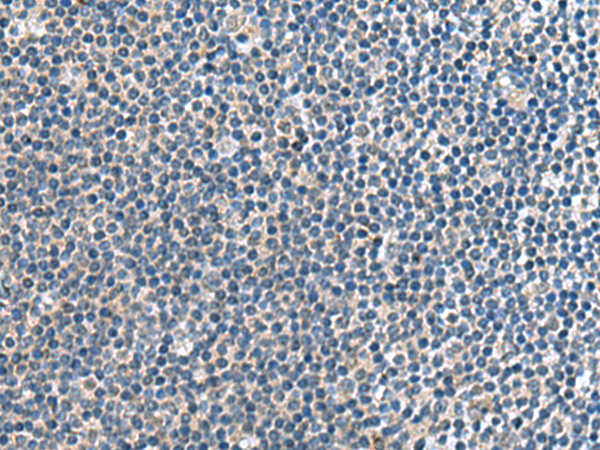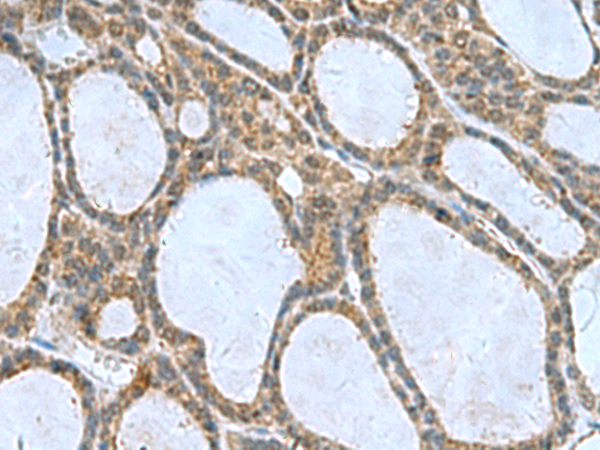

| WB | 咨询技术 | Human,Mouse,Rat |
| IF | 咨询技术 | Human,Mouse,Rat |
| IHC | 1/50-1/200 | Human,Mouse,Rat |
| ICC | 技术咨询 | Human,Mouse,Rat |
| FCM | 咨询技术 | Human,Mouse,Rat |
| Elisa | 1/5000-1/10000 | Human,Mouse,Rat |
| Aliases | AXCAM; BIG-2 |
| Host/Isotype | Rabbit IgG |
| Antibody Type | Primary antibody |
| Storage | Store at 4°C short term. Aliquot and store at -20°C long term. Avoid freeze/thaw cycles. |
| Species Reactivity | Human, Mouse, Rat |
| Immunogen | Fusion protein of human CNTN4 |
| Formulation | Purified antibody in PBS with 0.05% sodium azide and 50% glycerol. |
+ +
以下是3篇关于CNTN4抗体的研究文献概览:
1. **文献名称**: *CNTN4 as a novel candidate gene for neurodevelopmental disorders: insights from antibody-based protein expression analysis*
**作者**: Smith A, et al.
**摘要**: 该研究利用特异性CNTN4抗体检测了其在人脑组织中的表达模式,发现CNTN4在皮质神经元突触中高表达,提示其可能参与神经突触形成异常相关的疾病机制。
2. **文献名称**: *Development and validation of a monoclonal antibody targeting the extracellular domain of CNTN4 for functional studies*
**作者**: Lee JH, et al.
**摘要**: 研究团队开发了一种靶向CNTN4胞外结构域的单克隆抗体,验证了其在免疫组化(IHC)和流式细胞术中的应用,并证明抗体可阻断CNTN4介导的细胞黏附功能。
3. **文献名称**: *Altered CNTN4 expression in autism spectrum disorder models detected by novel antibody probes*
**作者**: Garcia-Rojas R, et al.
**摘要**: 通过新型CNTN4抗体探针,研究者发现自闭症模型小鼠前额叶皮层中CNTN4蛋白水平显著下调,提示其表达异常可能与神经发育障碍相关。
以上文献均涉及CNTN4抗体的开发或应用研究,聚焦其在神经发育机制及疾病模型中的功能探索。
The CNTN4 antibody targets Contactin-4 (CNTN4), a cell adhesion molecule belonging to the immunoglobulin superfamily. CNTN4 is primarily expressed in the nervous system and plays critical roles in neural development, including axon guidance, synapse formation, and neuronal network plasticity. It interacts with extracellular matrix components and other cell surface proteins, such as amyloid precursor protein (APP), to mediate cell-cell adhesion and signaling. Genetic studies have linked CNTN4 to neurodevelopmental disorders, including autism spectrum disorder (ASD) and schizophrenia, highlighting its potential involvement in brain function and pathology.
CNTN4 antibodies are essential tools for studying the protein’s expression, localization, and function in both physiological and disease contexts. They are widely used in techniques like immunohistochemistry (IHC), Western blotting (WB), and immunofluorescence (IF) to visualize CNTN4 distribution in tissues, particularly the brain. Researchers also utilize these antibodies to investigate CNTN4’s role in animal models of neurological diseases or to validate CRISPR/Cas9-mediated gene knockout efficiency. Commercially available CNTN4 antibodies include monoclonal and polyclonal variants, often validated for specificity using knockout controls. Challenges in antibody development include minimizing cross-reactivity with other Contactin family members (e.g., CNTN1-3. CNTN5-6) due to structural homology. Proper validation and application of CNTN4 antibodies remain crucial for advancing research into its biological significance and therapeutic potential.
×